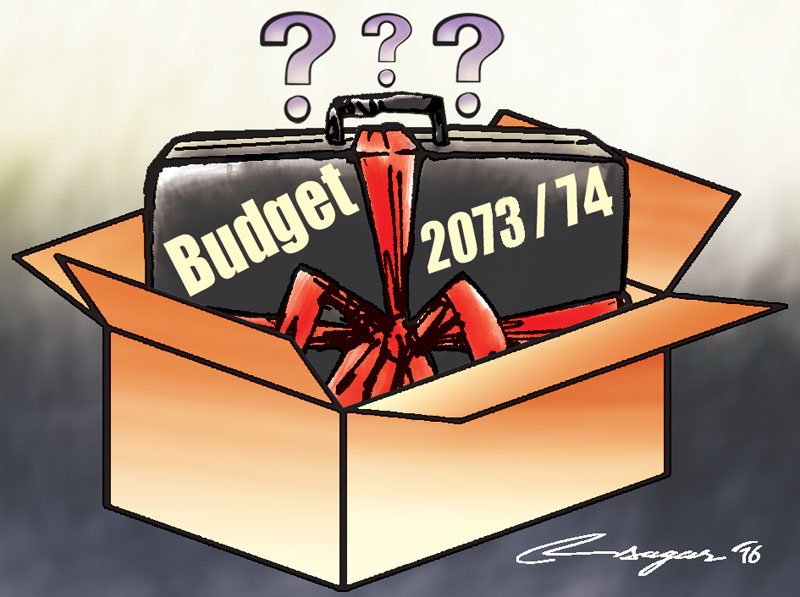Foreign aid’s share in budget may cross 30 pc
Estimates prepared by NPC, projections made by officials of Ministry of Finance
Kathmandu, May 22
If indications given by the government are anything to go by, the contribution of foreign aid in the budget of the next fiscal is likely to cross the 30 per cent mark.
Rise in foreign aid’s share in annual budget should not come as a surprise in a country where development needs are high but domestic resources are limited due to low economic growth.
But is this development financing model sustainable?
Nepal’s reliance on foreign grants and soft loans had actually dropped in fiscal year 2012-13 when the share of foreign aid in the annual budget stood at around 18 per cent from 26 per cent recorded in fiscal years 2010-11 and 2011-12.
Although that share went up to around 22 per cent in 2013-14, it fell to around 20 per cent in 2014-15.
Then foreign aid’s contribution to the budget suddenly jumped to 25.12 per cent in this fiscal year, largely because of higher funding needs for post-earthquake reconstruction and rehabilitation.
Now, that share is expected to balloon to anywhere between 30.65 per cent and 33.79 per cent in the next fiscal year, as more funds will be required for reconstruction and rehabilitation works.
These estimates were made based on figures presented in the draft approach paper of the 14th Periodic Plan, prepared a few days ago by the National Planning Commission, and projections made by officials of the Ministry of Finance.
The draft approach paper estimates the budget of next fiscal to stand at Rs 978.10 billion. To fund this spending, the government, according to the approach paper, is likely to mobilise Rs 231.43 billion in foreign soft loans and Rs 99.05 billion in foreign grants.
This means a total Rs 330.48 billion or 33.79 per cent of the projected budget of Rs 978.10 billion is likely to be mobilised in foreign aid in the next financial year.
The projection on foreign aid mobilisation is Rs 36.83 billion higher than foreign aid ceiling of Rs 293.65 billion extended earlier by the NPC.
Yet the caveat is the Ministry of Finance does not always follow projections laid in approach papers to frame the annual budget. This is likely to happen this year too, as the government is expected to register a treasury surplus of Rs 50 billion to Rs 100 billion by the end of the fiscal.
So, this amount will most likely be taken into account while finalising next financial year’s budget. This means next fiscal’s budget may balloon to anywhere between Rs 1,028 billion and Rs 1,078 billion.
If the size of next fiscal year’s budget swells to Rs 1,078 billion, the proportion of foreign aid in the projected annual outlay will stand at 30.65 per cent, considering the government’s plan to mobilise Rs 330.48 billion through foreign grants and soft loans.
Such a hike is expected to come at a time when the latest Development Cooperation Report of the MoF has sounded alarm bells over fragmentation of aid money, as each development partner operating in the country worked with eight ministries or agencies on average in the last fiscal year, scattering financial resources in a number of projects or programmes.
The Organisation for Economic Cooperation and Development says aid fragmentation pushes up ‘transaction costs, making it difficult for partner countries to effectively manage development’. This, in turn, erodes effectiveness of projects.
Considering the negative impacts of aid fragmentation, the government has introduced sector-wise approach in foreign aid utilisation, under which resources from several donors are pooled to support a sector.
This joint financing arrangement has been implemented in education and health sectors.
“It would benefit the country if similar arrangement is introduced in the physical infrastructure sector. This will help us build selected but strategically important infrastructure projects,” Narayan Dhakal, under secretary at the International Economic Cooperation Coordination Division of the Ministry of Finance, told The Himalayan Times.
But many donors, especially bilateral, do not want to participate in such programmes because they do not get recognition for contribution they have made, as their names get buried among other development partners engaged in the work.
Also, what is true is sector-wise approach introduced in education and health sectors has not produced desired outcomes because of weak governance and defects in the country’s policies and institutions.
“Foreign aid is not the panacea. But it is helpful for countries that have just begun climbing the rungs of development,” said Dhakal. “So to reap maximum benefits a country must hone its negotiation skills to divert aid to priority areas.”






